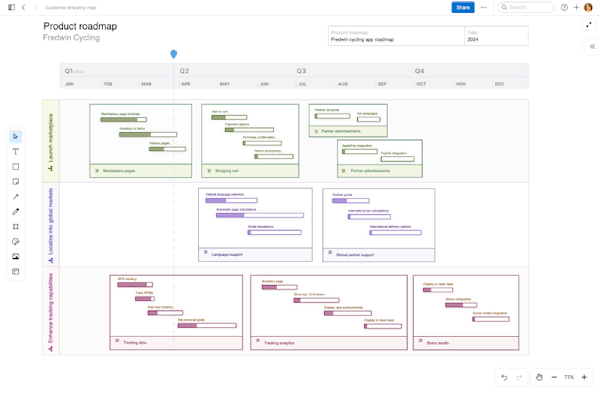How to build a roadmap for a new product
Last updated: July 2024
A product launch is an exciting privilege in many ways. It is rare that you get to be part of building something entirely new, and the energy and pressure will be high. As a product manager, you will be pulled in countless directions. You need to review market data, write positioning statements and user stories, and outline the customer journey. But one area of focus demands your full attention: the product roadmap.
New product launches contain many deliverables and dependencies from cross-functional teams. You need to account for feature definition; design and development; testing and refinement; training across marketing, sales, and support; and customer communications. A roadmap helps you center the team around a timeline — so everyone can contribute with purpose toward your common goal.
Although we will primarily explore building a roadmap for a new product here, the recommendations in this guide can apply to any new service or even new, meaningful functionality within an existing product. All of this work requires immense cross-functional collaboration and launch planning. As you get into the details, also keep in mind that how your organization builds products depends on the methodology you follow. Our approach is most applicable to software companies that subscribe to more agile practices, but it is certainly adaptable.
Let's begin! Feel free to skip around to different sections as you would like:
What is a product roadmap, and why is it important?
We built Aha! around the concept of strategic roadmapping, so we have a lot to say on the topic. If you are a PM who owns new product development, you probably have a lot to say too. But product roadmaps are likely familiar even if you are just getting started in product work.
Our take is unique because we recognize the need to connect goals and initiatives to the detailed work on a roadmap — so stakeholders and teammates can see how the work helps you achieve your product vision. In short, a product roadmap is a visual tool that communicates your goals and initiatives, maps them to feature work, and includes a timeline for delivery.
But a roadmap is not just a communication tool; it is a commitment. Laying out clear milestones and time frames holds the team accountable and drives focus. A well-crafted roadmap rallies the organization, aligning cross-functional teams around a common purpose and ensuring every action propels your new product forward.
Hear more on product roadmapping from the Aha! team below:
Editor's note: Although the video below still shows core functionality within Aha! software, some of the interface might be out of date. View our knowledge base for the most updated insights into Aha! software.
Related:
Roadmap planning for new products
Building a product roadmap always begins with strategy. You need to understand the market you plan to serve and the problems your product will solve for customers. This information will help you define the "why" behind your product and how it will support the business overall.
Getting to this strategic inflection point might take a good deal of upfront work. This is especially true if you are launching a new product as well as a new company. Before doing product roadmap planning, you have probably spent time on foundational work that includes:
Conducting in-depth market and customer research
Completing a competitive analysis
Defining your vision (the north star you will vet product decisions against)
When launching a new product within an existing portfolio, you might have already completed this foundational work. However, you will need to revisit some steps: setting product goals, defining initiatives, writing new product positioning, creating customer personas, and more. This will help inform what you put on your product roadmap.
Let's assume much of this foundation-setting is complete. (If not, you are still in the right place. Lean into all the companion guides listed below to get started.)
Related:
Going forward, we will assume that your high-level company strategy is complete, you are launching a new product at an existing company, and you are ready to build the six- to 12-month roadmap for the new product.
Set product strategy
After you review the overall business strategy, narrow in on the goals and initiatives you will deliver for the new product in the portfolio:
Product goals should be measurable, achievable, and time bound. (We will talk more about time and launch dates later.)
Initiatives represent the broad areas of work that will help you achieve your goals. Initiatives can be broken down into epics and features and then organized into releases as plans progress.
Part of determining the above is understanding what is required to deliver real value to customers. At Aha! we focus on delivering a Minimum Lovable Product (MLP) — this means we want a new product to be lovable (even as we plan to improve it over time) rather than merely tolerable. Starting with an MLP mindset can help differentiate your product in the marketplace and lead to longer-term success.

This is an example of strategic product goals in Aha! Roadmaps.
Gather stakeholders
You have a rough sense of your product goals and initiatives. Now is a good time to share them with leadership and other stakeholders. Depending on the size of your organization, this might be just a few people or a large gathering. Think the CEO, CPO, CIO, and leaders across engineering, marketing, sales, and customer support. (A stakeholder map can help you make these distinctions.)
Stakeholder alignment at every stage in the product development process is essential — but it is even more essential when setting goals and initiatives. After all, these underscore everything that comes next.
Get the stakeholder map below — with a free trial.
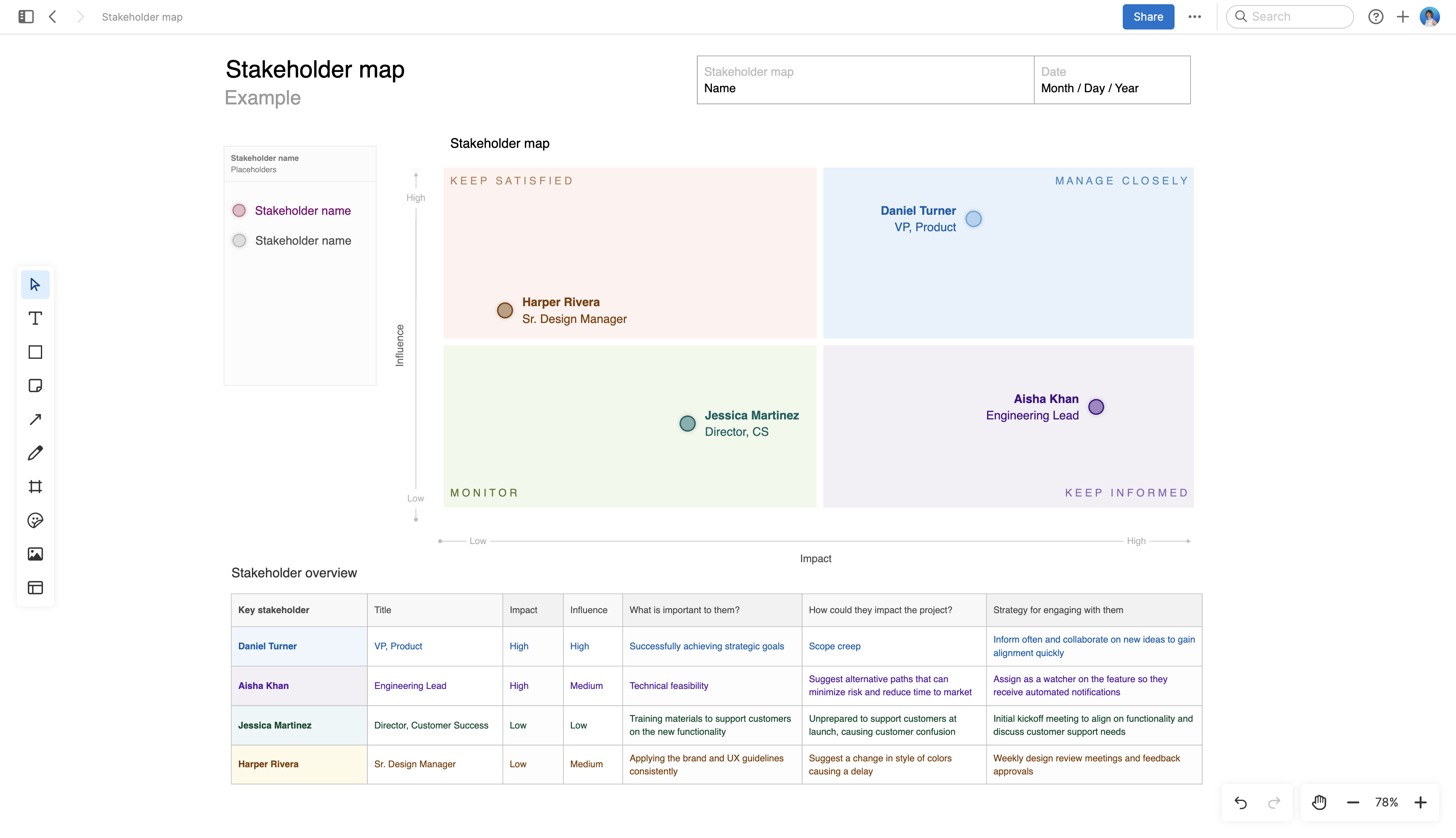
Embrace stakeholder feedback. These folks have to believe in the new product as much as you do to help the organization build, support, sell, and market it.
Related:
Explore early-stage concepts
Do not rush to the roadmap just yet. Early-stage planning and ideation are crucial for your new offering. This phase allows you to break goals and initiatives into their subsequent parts: the areas of functionality required to drive product adoption.
Start by gathering ideas from potential customers, colleagues, and partners. If you have an idea management platform, use it to capture feedback that can help determine which features will be most valuable to future users.
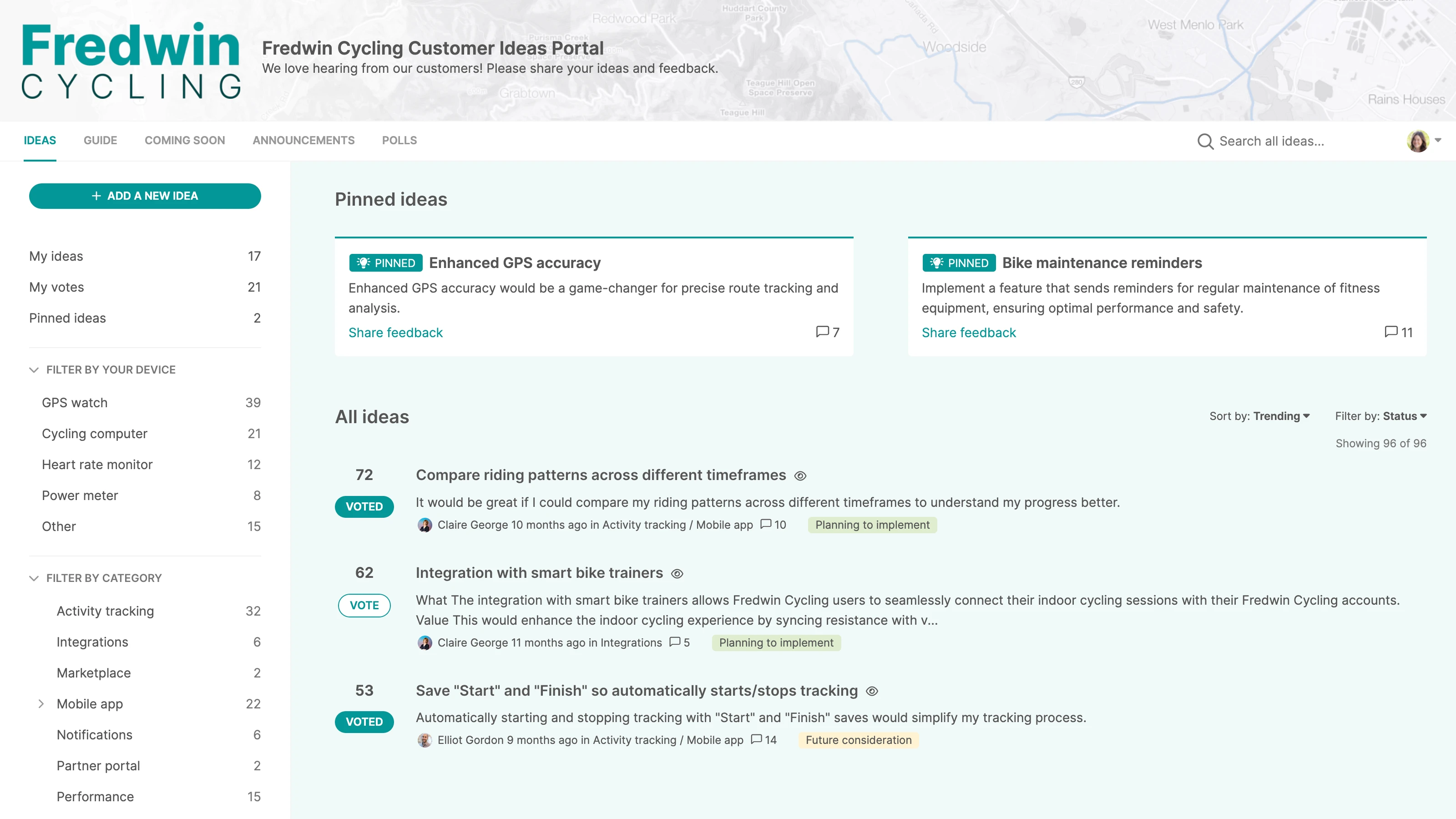
This is an example of an ideas portal created through Aha! Ideas. (Many of the basic capabilities in Aha! Ideas are also available in Aha! Roadmaps.)
Product teams often utilize virtual whiteboards — such as the options available on Aha! Whiteboards — to brainstorm product ideas and explore initial concepts. Whiteboards are where you sketch designs and create wireframes that help illustrate the ideal user experience with your product.
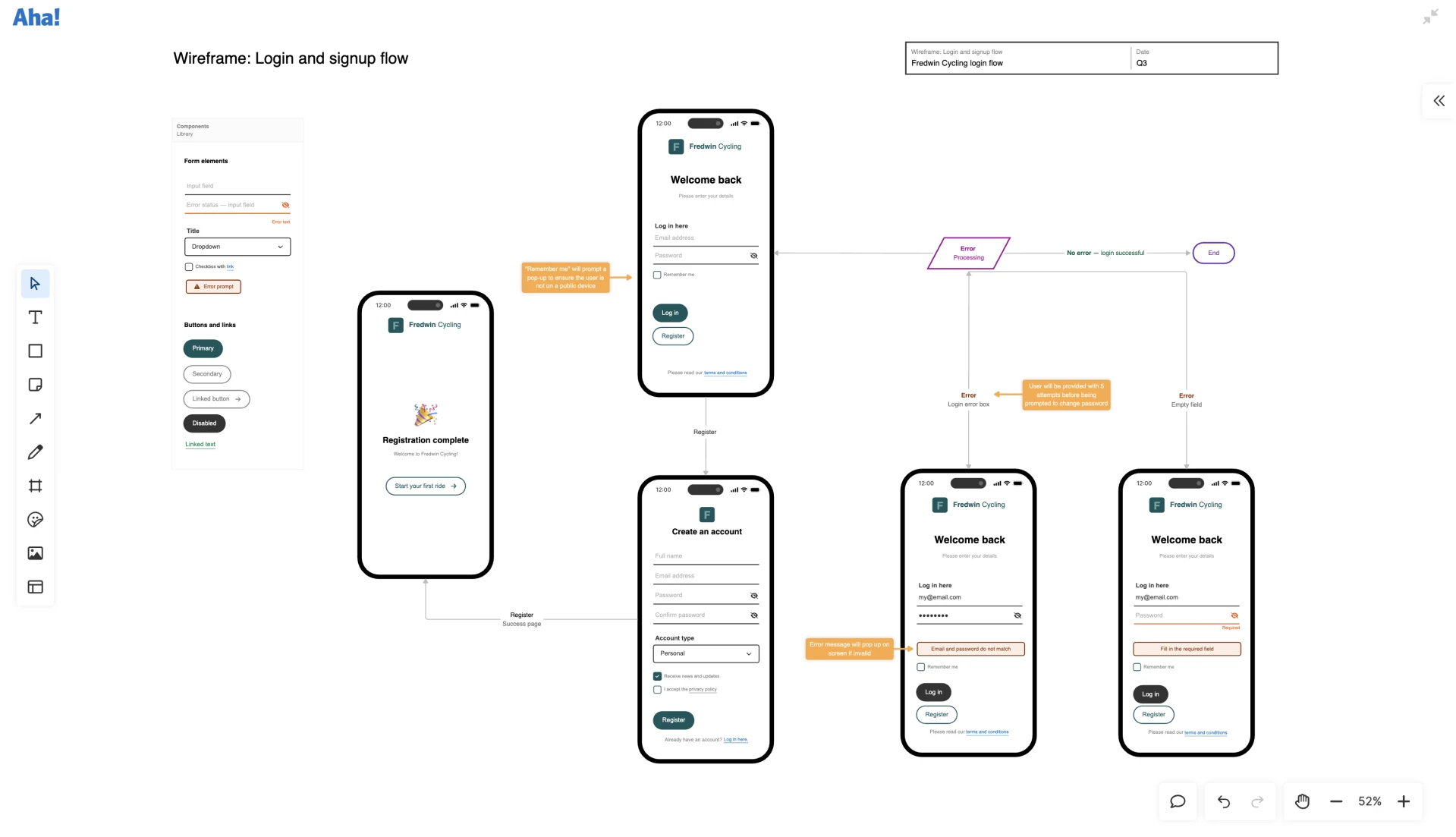
For example, use this signup wireframe template in Aha! Whiteboards to map out your application's ideal login flow.
As product concepts take shape, share them with stakeholders, gather more feedback, and make revisions. When everyone feels confident about the proposed functionality, it is time to plan out the actual work that will make your product come to life.
Related:
How to move early-stage whiteboard concepts to your product roadmap
How to use a digital whiteboard to kick off product planning
Formalize product plans and build the roadmap
This next stage of product planning focuses on the details. Define features (or pieces of functionality) and scope out what it will take to complete the work. Scoping a feature often includes:
Tying it to strategy: Detail how the feature is connected to your larger product strategy and launch.
Defining a user story: Describe how different users will interact with the feature.
Identifying requirements: Outline what functionality the feature needs to achieve.
Estimating effort: How much time, effort, and capacity is required to build the feature?
As these details become clear, use them alongside a prioritization framework to make trade-off decisions about which features are necessary for launch. Then, organize them into current and upcoming releases on your roadmap.
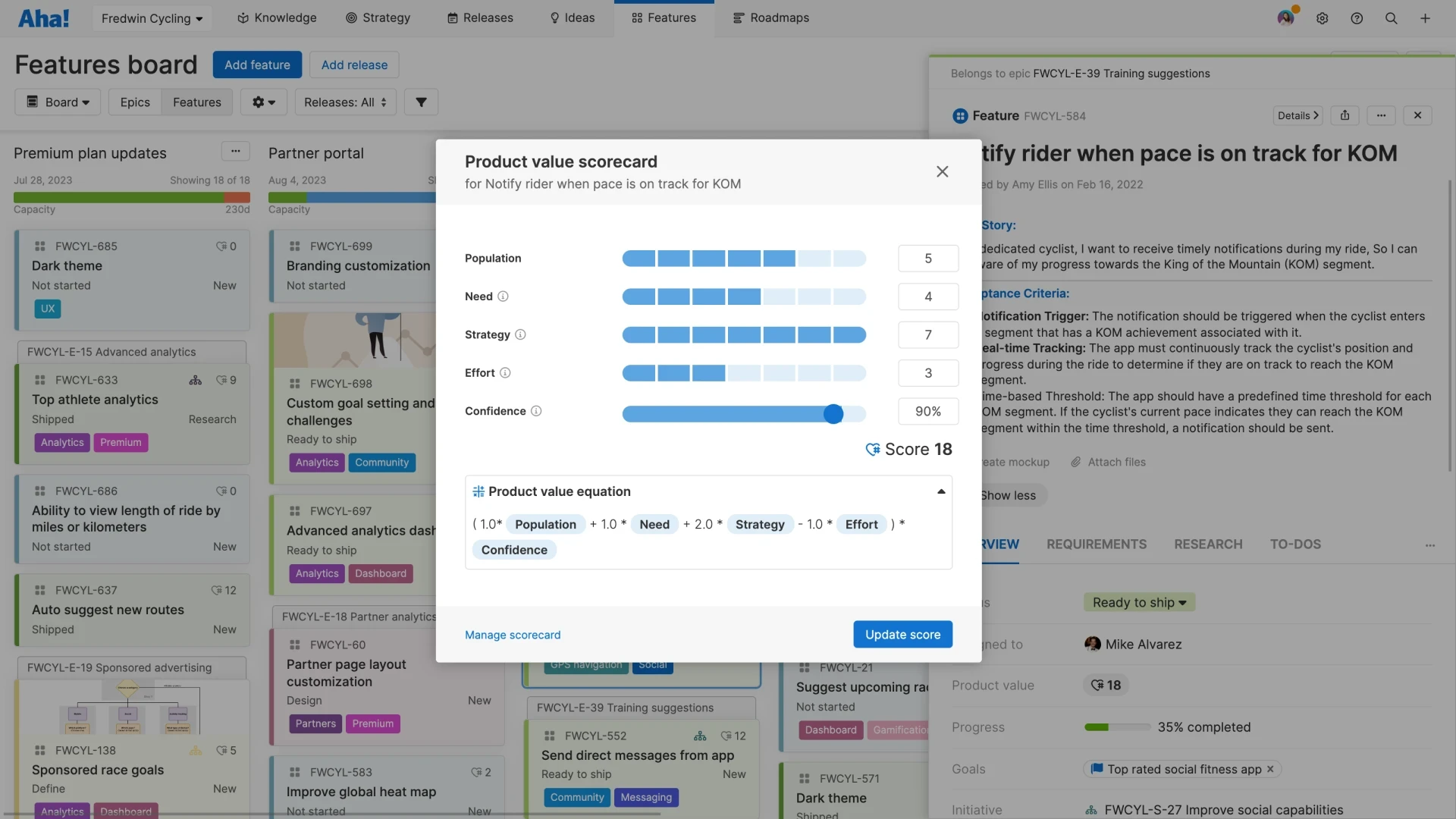
In Aha! software, the product value scorecard allows you to objectively assign value to each feature using metrics, scales, and weighting.
Throughout the planning process, you will likely identify new features that are not launch-critical. These can be included in your post-launch backlog or longer-term roadmap.
Now you are ready to build your six- or 12-month roadmap! These are the most essential roadmap components to include right now:
Goals | Clear, actionable objectives tied to user needs and business-level goals |
Initiatives | Broad themes of work that will help you achieve product goals |
Releases | All the work that must be completed to deliver the product or new experience to customers |
Features | New functionality that will be delivered as part of a release |
Timeline | The time frame in which you plan to launch the product and/or deliver new features, updates, and enhancements |
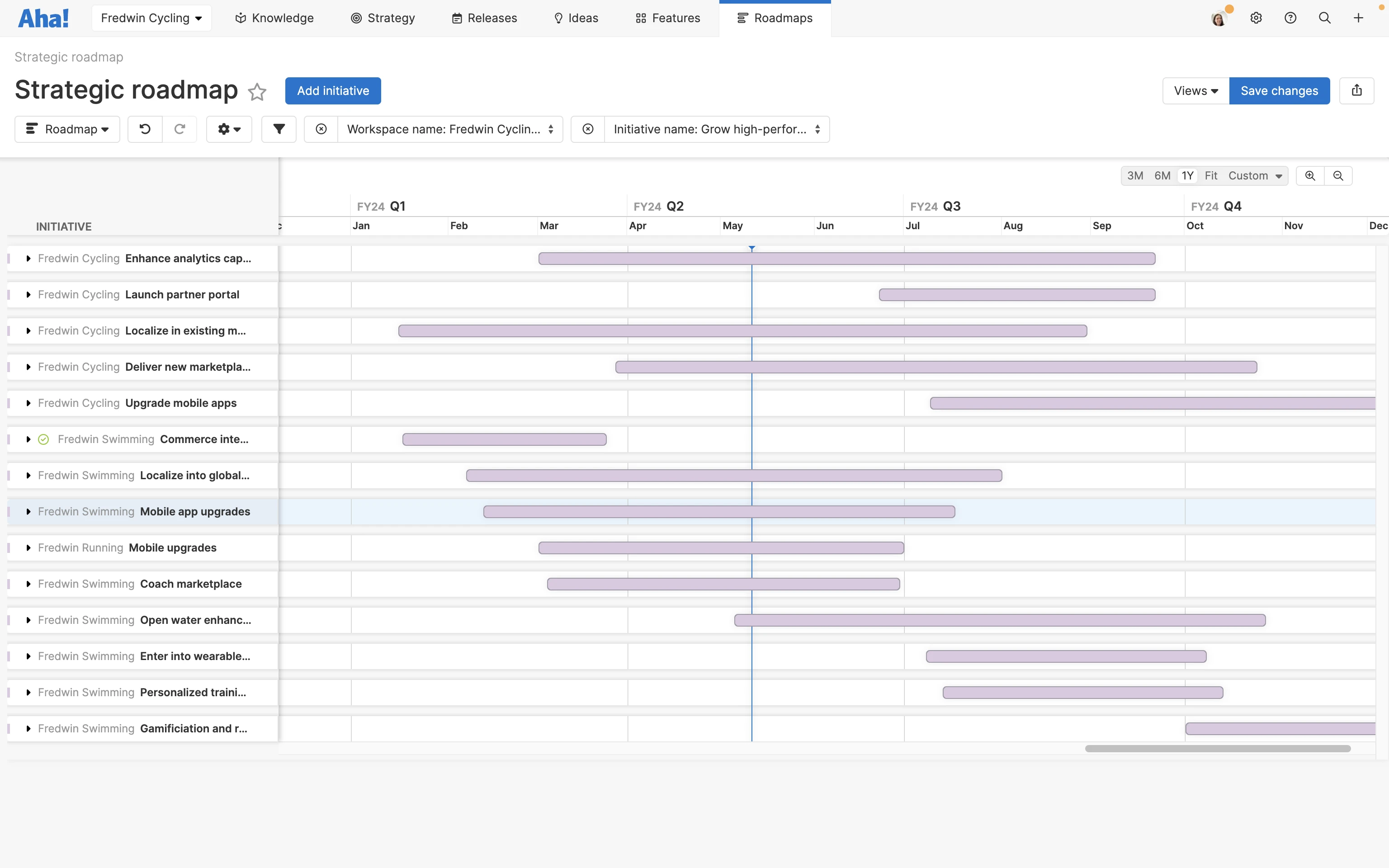
This strategic roadmap in Aha! Roadmaps is a visual timeline that communicates how your work ties back to higher-level initiatives.
Building a roadmap draft is a great achievement. It requires deep analysis and collaboration with executives and cross-functional teams, and especially engineering. You want to make sure you set a realistic launch date for the new product and that the engineering team has the time and resources it needs to build everything according to the plan.
With your roadmap draft in hand, now is a good time to check in with stakeholders again. They already have an understanding of your product goals and initiatives as well as initial product concepts, so visualizing the actual work on a roadmap will undoubtedly be exciting for everyone!
Coming out of these sessions, you should be ready to revise and finalize the roadmap. Of course, its finer details will change as time and learning progresses. But it is important to follow its high-level direction — it represents a real plan everyone is committed to achieving.
Related:
Customize roadmap views for various audiences
Everyone in the organization has a stake in the new product's success, so it is important to share the roadmap broadly (and answer questions about it). This is where different roadmap views are super valuable.
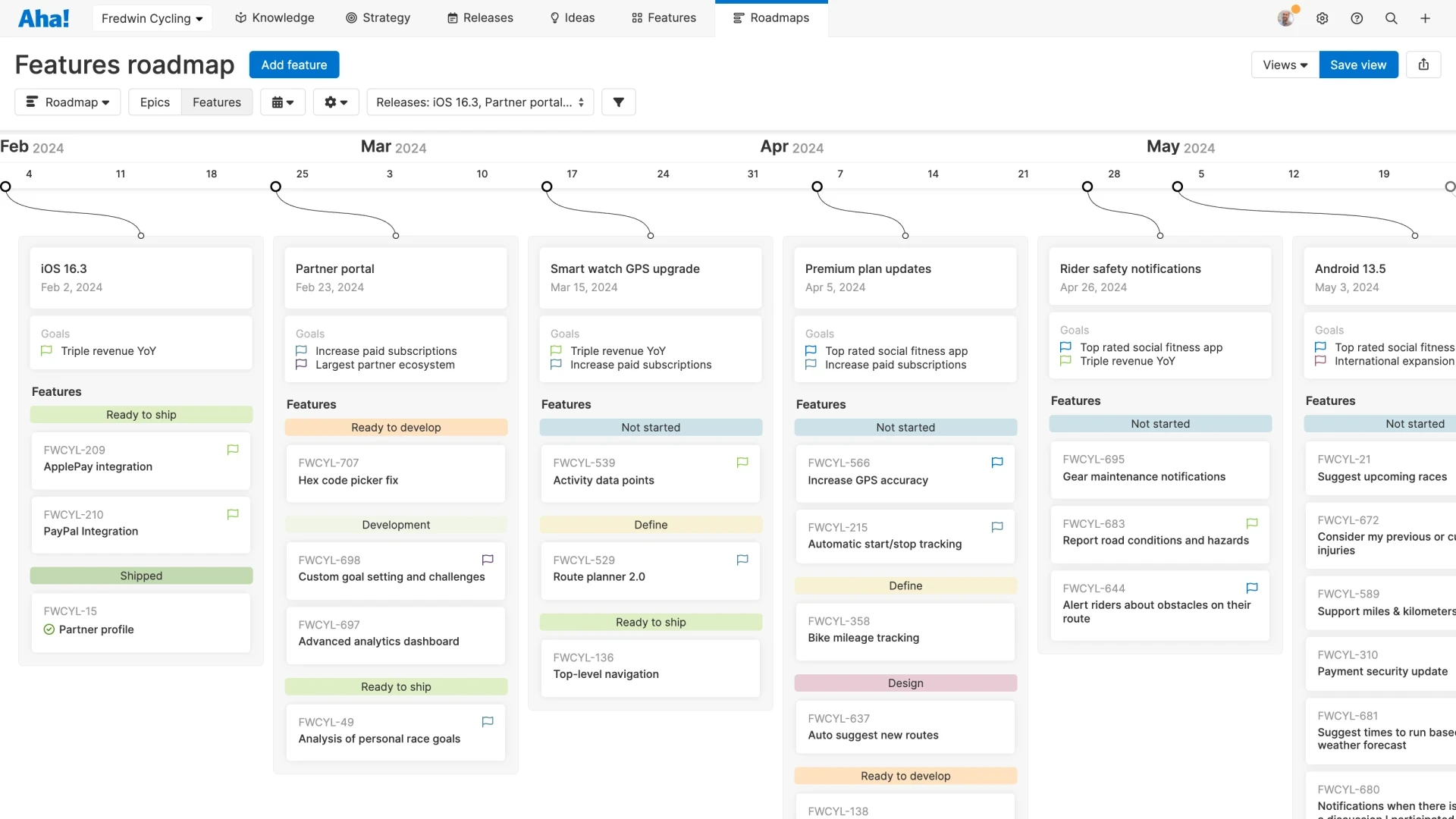
A features roadmap shows the specific functionality your team is building, along with a time frame for delivery.
Fortunately, a roadmapping tool such as Aha! Roadmaps makes it possible to create your product roadmap once — then build different views based on the same data.
Here are a few of our favorite views and who they are best suited for:
Product roadmap: Think of this one as your "default" — the original version that shows goals and initiatives (and perhaps some important epics or features) as well as the overall launch timeline.
Great for: Everyone! (This is the one most stakeholders will want to see before switching to a customized view.)
Features roadmap: A more detailed view that includes features mapped to releases or delivery dates
Great for: Engineers and designers
Release roadmap: A Gantt-style roadmap view broken down into phases of work with key milestones and dependencies
Great for: Teams involved in the details of the work that need to understand cross-functional dependencies
Epics roadmap: Displays upcoming work by grouping related features under one umbrella that might span multiple releases
Great for: Engineers, designers, team leads
Portfolio roadmap: Showcases an entire portfolio and helps people understand how plans relate to one another
Great for: Product leaders, product operations managers
Strategy roadmap: Similar to the original product roadmap, but likely zooms out a level (or two) to show how the new product strategy fits into everything else the company is working on
Great for: Leadership teams
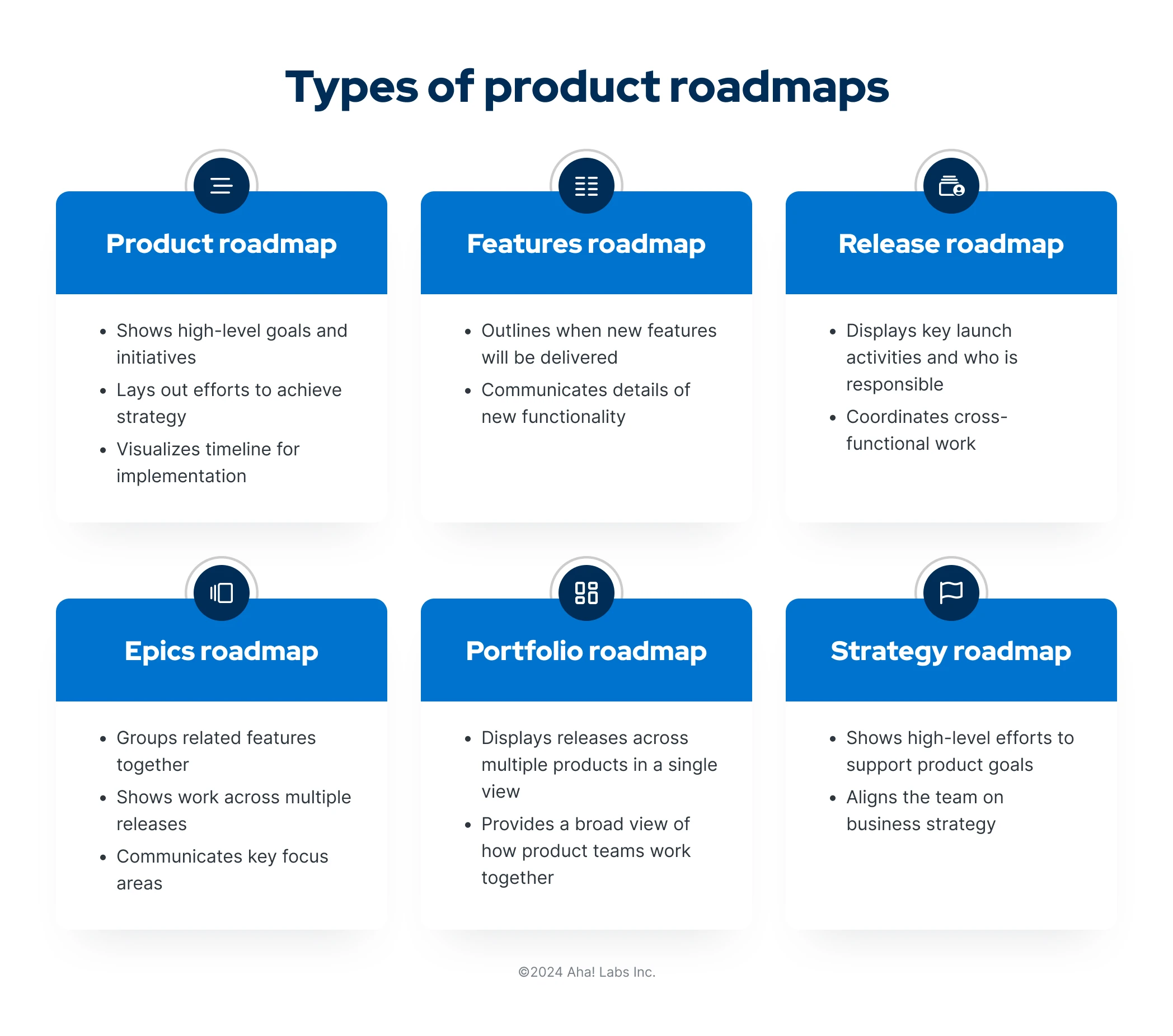
Related:
Product roadmap vs. go-to-market roadmap
There is another roadmap view that is particularly important for a new product launch. We refer to it as a go-to-market roadmap. But some people might call it a product launch roadmap, marketing launch roadmap, or product rollout plan.
All of the roadmap views discussed in the section above center around bringing your new product from concept through to delivery. However, it is still essential to visualize all of the work that must happen in other areas of the organization (such as sales, support, and marketing). These teams might develop their own roadmaps, but it is important for the product manager to keep all plans aligned.
A go-to-market roadmap can display phases and deliverables in these areas:
Financial information: Changes or new work related to product pricing or billing processes
Marketing support: Launch announcements, website changes, promotions or campaigns, knowledge base updates, and so on
Sales support: Training and sales enablement
Customer support: Training, support documentation, and support ticket processes
Related:
Additional words of advice
We have covered a lot of ground already, but here are a few extra tips to help make your new product build go brilliantly:
When your roadmap is ready, show it off: Create a product roadmap presentation to keep your stakeholders in the loop on progress and timing.
Develop a product launch checklist: Also known as a product launch plan, a product launch checklist breaks down all the launch-related work into specific tasks. This will help the team coordinate and track release activities, deliverables, and dependencies using a repeatable process. (Better yet, you can manage all the tasks in a workflow management tool such as Aha! Roadmaps.)
Publish an external product knowledge base: A knowledge base provides self-serve support documentation for customers. Beyond answering how to do something in your product, a great knowledge base functions as a continual source of learning for your users.
Develop an internal product wiki: This should include any documentation the cross-functional product team and other stakeholders should have on hand so they can plan, build, and deliver your product.
What comes next?
Before you kick off the next phase of product development (building), celebrate your success. Crafting a strategic and comprehensive roadmap that galvanizes the organization is a huge feat. The months that follow are the critical time to get busy and deliver on what you have promised.
Launch day will be here before you know it. Be ready to collect feedback from customers, partners, stakeholders, and teammates in the days, weeks, and months after launch. Their ideas are the fuel that will move your product forward.
If you have not already, invest in a defined idea management process so you will be able to sort through requests, prioritize the best ones, and create a backlog of enhancements that align with your goals.
A new product launch is thrilling. But it is the work that comes after that ultimately determines your success.

